Manger – Acoustical reality
AT LAST: A LOUDSPEAKER BASED ON HUMAN PERCEPTION
I am often asked why I am in the business of sound reproduction. Stated simply, it is due to dissatisfaction with the performance of conventional loudspeakers which to me sound quite unlike the original.
To my ears and those of others, the conventional loudspeaker does not convincingly reproduce the timbre of percussive instruments. The spatial information in stereo signals is not properly revealed, and the loudspeaker itself gives a permanent reminder of its presence due to a tonal and spatial footprint which crushes the subtleties in the sound to be reproduced.
My goal has always been to overcome these problems to achieve a quality of reproduction approaching the original experience both tonally and spatially. This has required extensive research into both human hearing and transducer design and has led to the world’s first travelling wave transducer design.
Conventional wisdom cannot explain the Manger sound transducer, but then conventional wisdom has not significantly advanced the performance of traditional loudspeakers which repeat today the same mistakes which were clear years ago. To account for the performance of the Manger transducer, I would simply quote the Chinese saying: You have to swim against the stream to reach its source.
In my case swimming against the stream led away from tradition and into fundamental research into just how much the human listener could perceive and into the hearing mechanisms involved. Particular emphasis was given to a study of the human direction sensing mechanism. This showed that in addition to the well established system of pitch recognition on sustained notes, the ear has an evolutionarily older mechanism by which it locates a sound source through transients.
This mechanism is very powerful because it is the descendant of a highly evolved survival technique from the dawn of mankind, where the slightest noise, such as the snapping of a twig, would represent a threat to survival. Noises of this kind were useful information for all species throughout the world. Speech and music specific to the locality came much later, the noise of machinery later still.
Transient noises produce a one-off pressure step whose source is accurately and instinctively located. If these transients are not accurately reproduced, the subconscious direction finding mechanism is defeated. The sound becomes unrealistic, the stereophonic image is impaired and the result is listening fatigue.
This research led not just to a confirmation of why the traditional loudspeaker is so poor, but also to the specification of an ideal loudspeaker. From then on, the problem was simply how the specification could be met. I was told it was impossible, but I argued that if the human hearing mechanism could do it, then a man-made device could also do it. After a great deal of development, the required result was obtained.
In my view, an accurate loudspeaker system should be capable of reproducing all types of sound equally well. It does not matter whether this is a musical concert or a discussion. It is just as important to be able to reproduce natural sound such as birdsong and the wind in the trees where the only human contribution is the sound of a distant church bell. The loudspeaker itself should contribute nothing to the experience; no resonances and no clues in the sound field to reveal its dimensions.
The great majority of today’s loudspeakers are only designed to reproduce sustained notes and frequently employ resonances to augment this process. From the standpoint of human perception this is quite wrong because any resonance damages the transient response and leads to unrealistic sound and poor imaging. Loudspeakers should be aperiodic, i.e. they should have no resonances at all.
As conventional loudspeakers are built by tradition rather than science, myths abound. One of these is that a good professional monitoring loudspeaker cannot be a good hi-fi speaker. It seems to me that a loudspeaker which is only good for certain applications is probably not good at all. Provided it is powerful enough, surely an accurate loudspeaker should be equally useful in a wide range of applications. It is irrelevant whether the use is for relaxation, entertainment, professional recording, audiometry or in the testing of microphones. Conventional wisdom suggests otherwise, yet this is exactly the range of applications where the Manger sound transducer will be found today.
»Human hearing evolved initially as a survival mechanism to locate a potential threat. Today our hearing still works by analysing the first transient pressure change from a sound source. Unlike traditional speakers, the Manger sound transducer accurately reproduces transient pressure changes to give stunningly realistic sound. This booklet explains why transient response is so important and how the unique Manger sound transducer works.«
Josef W. Manger
Josef W. Manger has been active in transducer research and development for nearly thirty years and began manufacturing in 1985. He holds 40 patents and in 1982 was presented with the Diesel medal, one of Germany`s highest awards for engineering excellence.
1. The traditional explanation of human hearing
In a periodic sound there are two quantities which determine what the human listener will perceive. Fig. 1 shows that the first is the frequency which will be interpreted as the sensation of pitch. The second is the amplitude which will be interpreted as loudness. Where the sound is sinusoidal, it will have a single frequency and a fixed period between similar points on the wave. The distance sound can travel during one period is the wavelength lambda.
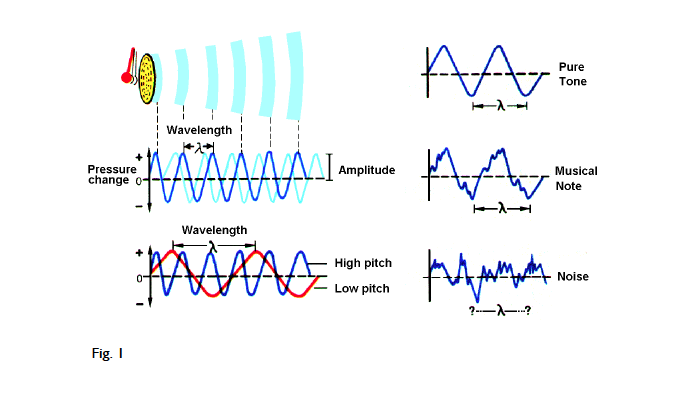
Sine waves seldom occur naturally. Real sounds contain many frequencies at once. This was first given a scientific basis by Fourier who showed that any sound can be made by adding sine waves of various frequencies. An electrically generated sine wave is a useful test tool and loudspeakers must be able to reproduce such a signal.
In the case of a pitched musical instrument, a small number of extra harmonics give the sound a characteristic timbre (right centre in the figure). In the case of noise or transients there is no limit to the number of frequencies which may be present.
The human hearing mechanism is a biological transducer and psychoacousticians have studied it extensively in an attempt to model its behaviour mathematically. The frequency analysis of the ear is carried out by the basilar membrane which is enclosed within the spiral cochlea or inner ear. The basilar membrane resonates to continuous tones at different frequencies along its length, determining the frequency limits of human hearing. After resonance has begun, the physical position or place of the resonance along the membrane allows the listener to determine the pitch. In case of a timbral sound the harmonics will excite a specific pattern of spaced resonances which will be unique for each type of instrument allowing the listener to recognise its type.
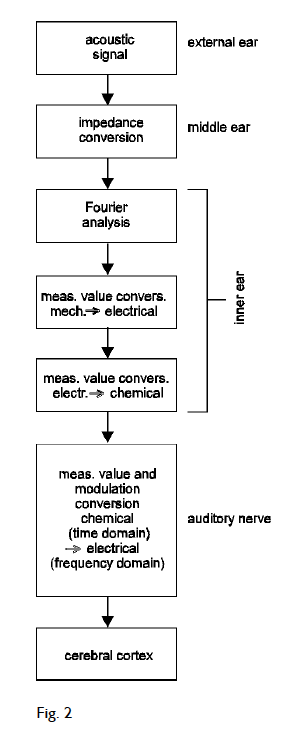
This analysis of hearing is called the place theory and it models the response to continuous tones quite well as Fig. 2 shows. Despite that, studies remain incomplete. In 1987, Zenner phrased the problem as follows:
»These (sensory cells) in the basilar membrane perform the vital task of converting the mechanical sound signal into a bioelectric and biochemical signal. The precise connection between the two is not known at the present time.«
As far as the traditional loudspeaker is concerned, little has changed since then. It is considered sufficient to produce a level frequency response to continuous tones, crossing over between as many different drive units as necessary, and generally using resonance to augment low frequency response. If this is an adequate specification, why is it that loud-speakers which all meet it can sound so different?
2. Perception and hearing explained by new research
The human hearing mechanism does not just detect the existence of sound, it also estimates the direction of the source as well as analysing the content of the sound to determine the most likely cause. In musical sounds, the pitch will also be determined. Josef Manger has been studying these mechanisms for over 20 years. He has found that each mechanism takes a different time to operate following an initial transient. The location and nature of the sound source are completely discerned before the pitch is recognised.
Pitch and timbral recognition is described by the well-established place theory, described in Part 1, in which different parts of the basilar membrane resonate according to the frequencies in the sound. However, various authorities, such as Keidel, Spreng, Klinke and Zenner, have suggested that there is another, faster acting, mechanism which works in the time domain.
The theory could not be tested with conventional loudspeakers. Confirmation of the theory was not possible until Josef Manger used his newly developed transducer as the sound source.
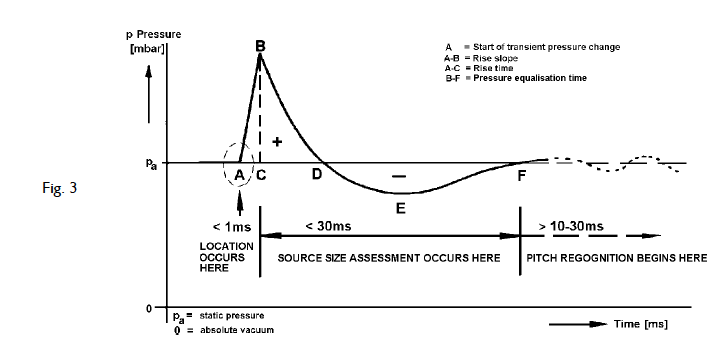
Fig.3 illustrates this principle of transient analysis and shows an idealised transient pressure waveform following an acoustic event. There are three important points made in the figure:
- A complete cycle is quite unnecessary for the recognition of the sound source. Only the initial transient pressure change A-B is required. The time of arrival of the transient at the two ears will be different and will locate cause, i.e. the source laterally within around a millisecond.
- Following the event which generated the transient, the air pressure equalises itself along the line B-F. The period of time between B and F varies and allows the listener to establish the likely size of the sound source.
- Only after the recognition of the source from the transient is the pitch recognised according to the place theory of the basilar membrane from the part of the wave-form beyond F.
The information in the initial transient pressure waveform goes beyond locating the source. Fig. 4 illustrates how the size of a sound source affects the pressure equalisation time. Pressure waveforms from a hand gun, a rifle and a cannon are shown. It will be seen that the larger the source, the longer the pressure equalisation time.
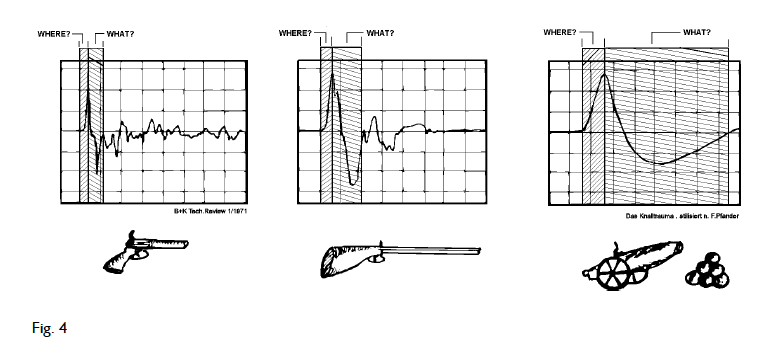
The above results suggest that anything in a sound reproduction system which impairs the reproduction of a transient pressure change will damage localisation and the assessment of the pressure equalisation time. Clearly a loudspeaker which claims to offer any degree of precision must be able to reproduce transients accurately.
3. Why traditional loudspeakers sound unrealistic
Although Part 2 showed that accurate transient response is extremely important for localisation and realism, the transient response of traditional loudspeakers is generally extremely poor. Step response testing tells a great deal about the performance of a loudspeaker. Fig. 5 illustrates pressure step testing. A pressure step cannot be maintained in air because the pressure equalises to static pressure. All loudspeakers (and our ears) act as high pass filters and when the voltage step at ¬ is fed to the loudspeaker, the flat top of the step will drop as the pressure equalises. The waveform resulting from an ideal loudspeaker can be calculated and is shown at . Any departure from this ideal waveform highlights a problem in the loudspeaker.
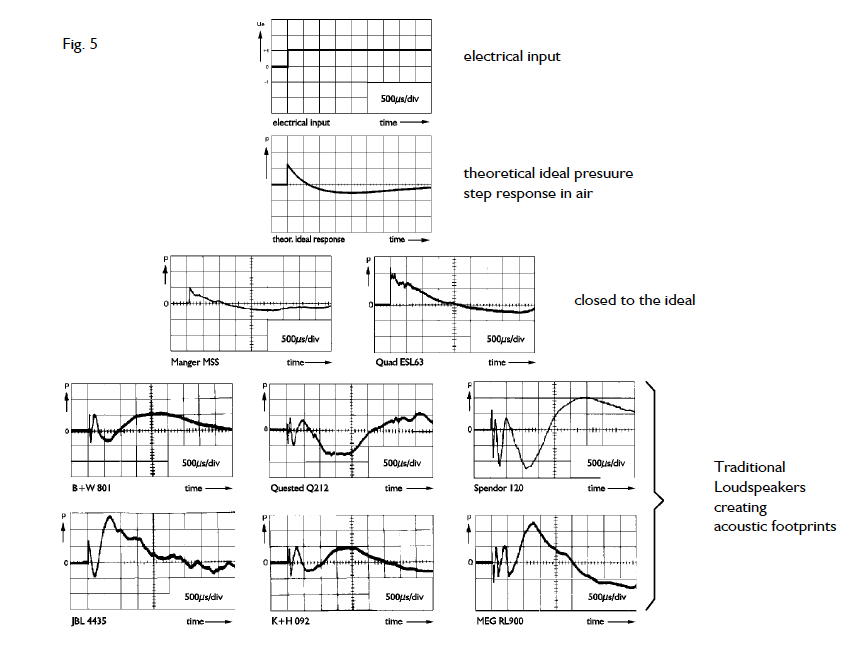
Note that amongst those tested the only loudspeakers which come remotely close to the ideal are the Manger MSS and the Quad ESL-63. The remainder are literally out of control during a transient.
Conventional wisdom only requires loudspeakers to have a flat response to continuous tones, and the phase response is generally neglected. The common protest is that “phase doesn’t matter“ or “the ear can’t hear phase“. People really think that. Most expensive loudspeakers employ at least three drive units which are fed with different parts of the frequency range by crossover networks. Again these are only designed for a flat frequency response and frequently rapid phase changes occur at the crossover frequencies.
The traditional way of extending the low-frequency response without an excessively large enclosure is to use resonance or time delay. Techniques such as reflex porting, Auxiliary Bass Radiators (ABRs) and transmission lines only work on steady tones and are unable to reproduce transient waveforms. The only low frequency technology which can reproduce the input waveform accurately is the sealed enclosure.
»Traditional loudspeaker testing is not incorrect in what it measures, but in what it does not measure.«
Josef W. Manger
Pressure step testing shows the inadequacy of these traditional approaches. Reference to Fig. 5 shows that the input waveform is simply not being reproduced. Instead these loudspeakers are issuing a noise which describes their construction rather than the signal. Note the sequential pulses where the top, middle and low frequency units respond at the wrong times, and in some cases the large low frequency oscillation due to the reflex tuning of the woofer.
This transient noise is responsible for the loudspeaker’s footprint which it superimposes on every signal. This is why loudspeakers sound different, because each has an unique footprint. In addition to causing listening fatigue, the footprint draws attention to the speakers themselves and their dimensions. The listener is forced to stay close to the “sweet spot“ midway between the speakers where the timing of the transient noise is the same at both ears allowing interchannel differences in the input signal to be heard.
The multiple pulses in the transient noise also causes the hearing mechanism to overestimate the level of the sound and the sensitivity of hearing goes down. The listener tends to increase the volume in an attempt to compensate. If you ever wondered why some engineers mix at such ear splitting levels, it is because their loudspeakers are replacing musical information with noise. Users call for ever more powerful loudspeakers which unfortunately are likely to be even less accurate. Research has shown that listening to poor quality loudspeakers at high level damages hearing more than listening with good speakers. Tragically, many audio engineers have impaired hearing.
4. A new beginning for loudspeakers
The Manger sound transducer was designed to meet the strict requirements of accurate transient response and good directivity, in addition to the traditional
requirement for uniform frequency response. The Manger sound transducer has a magnet and coil assembly as shown in Fig. 6, but there the similarity to a conventional speaker ceases. The diaphragm is perfectly flat, but it is not rigid. Although the diaphragm is flexible, it is made of a specially developed three-layer material which allows travelling waves.
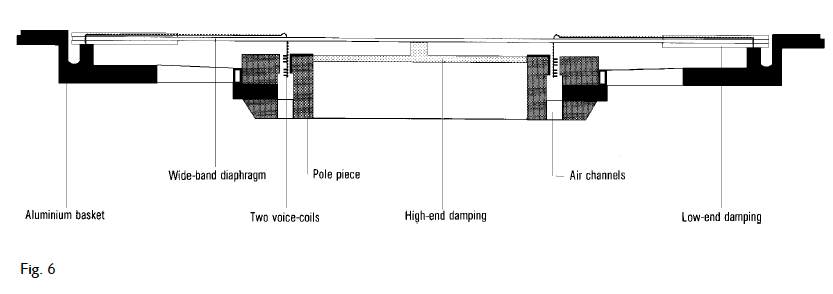
Over most of the wide working frequency range, the vibrations of the coil launch travelling waves in the diaphragm which propagate radially outwards until they are terminated in the star-shaped damping assembly which is visible at the perimeter. The propagation of transients down the basilar membrane in the inner ear occurs in exactly the same way.
The diaphragm is not uniform, but instead its characteristics change with radius according to a precisely determined law. This has a number of useful results.
Firstly, the radiating area falls with rising frequency. The lowest notes are radiated by the whole diaphragm whereas higher frequencies only use the centre. Thus instead of requiring a number of drive units of diminishing size, the Manger transducer is a single unit whose size varies continuously with frequency.
Secondly, the coil does not have to accelerate the whole diaphragm at once and so can have a very short rise time so that transients are faithfully reproduced.
Thirdly the radial propagation speed of vibrations through the diaphragm is carefully related to the speed of sound in air so that the phase of radiation from the outer parts of the diaphragm matches the phase of radiation from the inner parts which has propagated through the air. Fig. 7 shows that this results in a broad radiation pattern which avoids the narrow “beaming“ of conventional speakers.
When recently discovered requirements for a loudspeaker are properly met, listening takes on some important new dimensions. The fundamentally aperiodic nature of the Manger transducer means that the only periodicity in the sound applied to the ear must have been in the original signal. It is impossible to listen to a Manger transducer because it doesn’t have a “sound“. The footprint of the traditional loudspeaker is completely absent, allowing all of the information in the signal to be revealed to the listener.
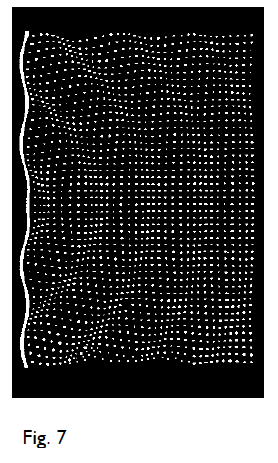
The Manger sound transducer has a rare combination of time, frequency and spatial accuracy and offers the following advantages:
- Greater realism: sounds are reproduced in a truly natural way. Enjoyable for the home listener and an essential tool for the professional.
- No listening fatigue: listen indefinitely. This is the hallmark of a truly accurate loudspeaker.
- No need to listen at elevated levels for critical assessment. Preserve your hearing! Although the Manger transducer is capable of high SPL, its sheer accuracy means that the listener instinctively matches the reproduced level to that of the original performance when the perceived timbre becomes correct.
- No sweet spot. Any sweet spot is due to the footprint of a poor speaker. With the Manger transducer the room is filled with a realistic sound field and listening can take place anywhere.
The realism of the Manger transducer is recognised instantly by everyone who hears sound reproduced by it. No musical or technical knowledge is required to appreciate this realism, nor should it be.


 English
English Eesti
Eesti Latviešu
Latviešu Lietuvių
Lietuvių
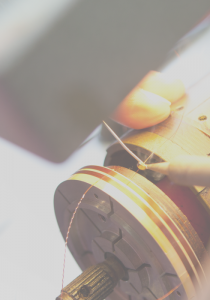
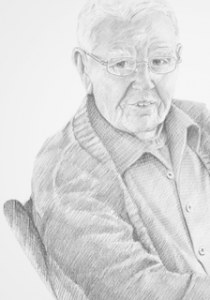


















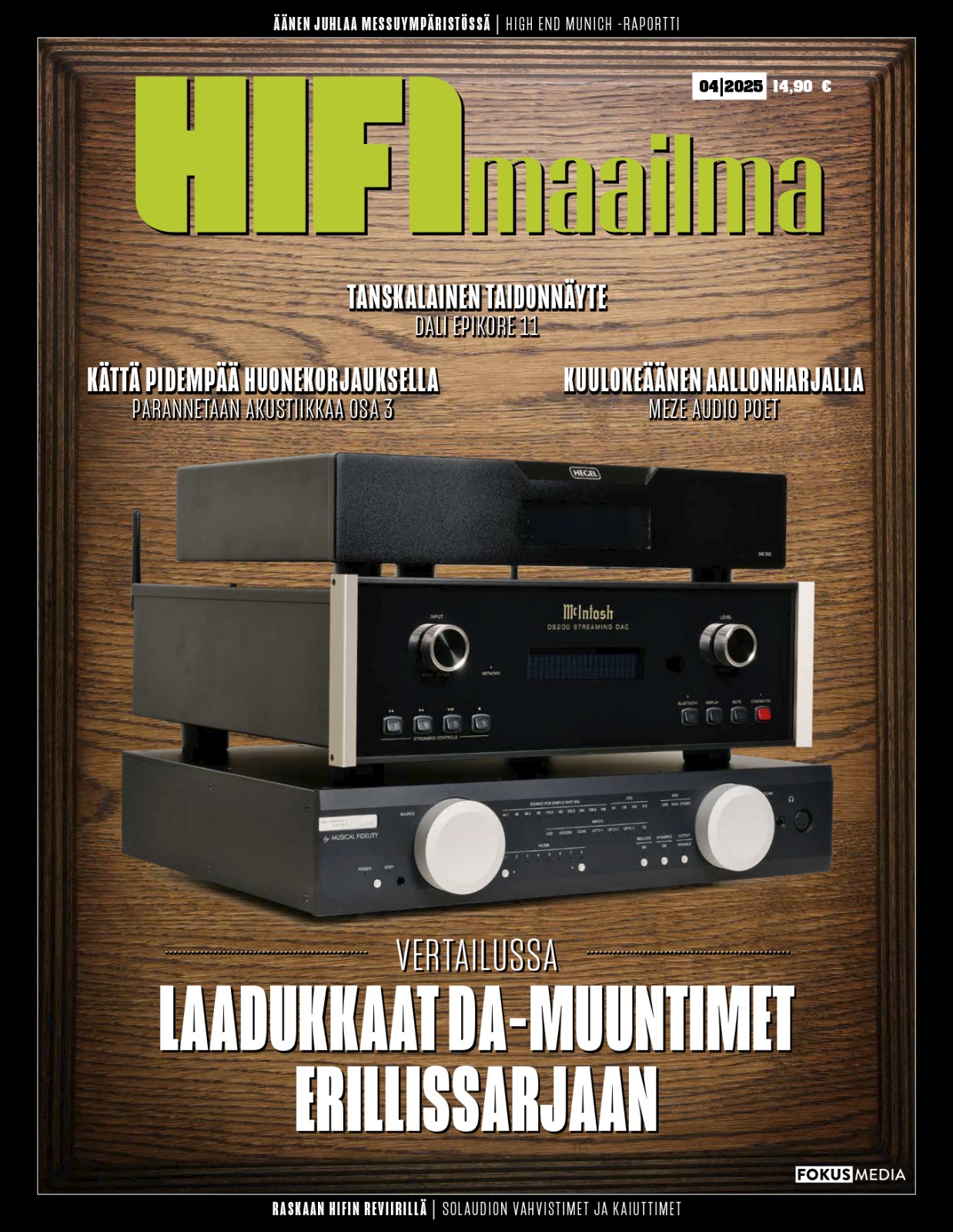

 seastone.audio
seastone.audio